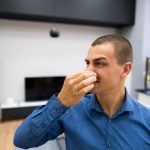Dinner lingering in the air from supper last night, diapers sitting in the trash can that should have been taken out yesterday, cat litter that your daughter was supposed to empty last week but somehow can’t break away from her phone long enough to do so.
Household odors can build up fast. And making the time to do housework is not always the easiest thing to do.
Table of Contents
Do air purifiers help with smell?
Yes. As long as an air purifier is using either carbon filtration or photocatalytic oxidation technologies.
HEPA filters will do very little to remove odors.
Getting rid of bad smells and lingering odors is not something any air purifier on the shelf is going to be able to do very easily.
Especially overpowering smells like fried fish and cigarette smoke, or strong odors like gas fumes or turpentine.
Most air purifiers feature HEPA filtration as their main air cleaning technology and though HEPA is the best at filtering out allergens like pollen and dust mites, the molecules that makeup average household smells are too small to be captured in a HEPA filter.
But there are a few other different technologies that will help breakdown and absorb the air particles that produce lingering smells.
 4 types of air purifiers that get rid of odors
4 types of air purifiers that get rid of odors
1. Activated Carbon or charcoal filtration
What is carbon filter in an air purifier?
The carbon filter in an air purifier is a spongy, very porous filter that absorbs
the tiny gaseous molecules that make up odors.
First. activated carbon and activated charcoal are the exact same thing.
Charcoal is a popular carbon substance so the two terms are used interchangeably.
Carbon is a extremely permeable material that attracts and retains VOCs (volatile organic compounds)
The filter is kind of like a charcoal sponge that is been activated with oxygen to attract molecules.
And being like a sponge, it is so porous that the molecules that are drawn into the spongy area get stuck inside of the filter.
The molecules were talking about are airborne particles that are smaller than .03 microns. Namely gases and chemicals that are responsible for bad odors or smells.
Carbon filters are always part of a filtration system that usually includes a HEPA filter and a larger pre-filter to capture the airborne debris that would clog the tiny pores if it were not filtered first.
 2. Photocatalytic oxidation
2. Photocatalytic oxidation
Photocatalytic oxidation or PCO for short is a technology that is very effective at reducing VOC’s. Which are the underlying cause of odors.
Vocs are generally what are considered to be the indoor air pollution that is caused by chemicals, and gases. Unwanted smells fall into this category.
PCO is a scientific process of combining ultraviolet light with titanium oxide and moisture.
The result of the process is what is called hydroperoxides.
Hydroperoxide is the gas form of hydrogen peroxide.
If that sounds familiar, it’s because hydrogen peroxide is a very popular antibacterial solution that is sold to pour onto a cut or an abrasion to keep it from getting infected. or to help kill the infection if it is already infected.
If you were able to take a bottle of hydrogen peroxide and spray or mist it on every airborne contaminant that is in your breathing space , you would essentially be doing what a photocatalytic oxidation air purifier does.
By creating a blanket a virtually millions of hydrogen peroxide ions and dispersing them through a room, the PCO process is able to disinfect your air much the same way as hydrogen peroxide is used to disinfect a wound.
Photocatalytic oxidation air purifiers do not require filter replacements either.
But since they do require ultraviolet light to work, the PCO module has to be replaced once a year or so.
Photocatalytic oxidation is also considered a ionic air purifier that creates ozone as a byproduct.
Most people might shy away when they hear but ozone is part of the process.
But photocatalytic oxidation is such an amazing technology for reducing germs, bacteria, and viruses, as well as odors,
It would be well worth looking into even using PCO is a secondary air purifier to run when there is no one home if the ideal of ozone is to scary or if the smell of ozone is too pungent.
Photocatalytic air purifiers or also used in induct air purification.
Houses equipped with HVAC systems can place induct PCO air purifiers into the ductwork of the central heat and air system and virtually turn the heat and air into a whole house air purifier that is rated high for mold spores,
viruses, and odor removal. and since most HVAC units are either in the basement or the attic , any ozone created in the PCO process dissipates before it reaches the ambient air.

3. Ozone generators
When you’re talking about heavy odors like third hand smoke that has been woven into the tapestry of a home and seemed to be part of the smell of the home itself, an ozone generator is like pulling out the big guns for strong odor abatement.
Ozone generators are not meant to be used in the vicinity of people, pets, and plants.
Though there are some ionic air purifiers that create ozone as a by-product and may not be considered dangerous for the amount of ozone they manufacture, that is not the case when you are using ozone specifically to reduce odors.
Ozone would not be considered a domestic air purifier but you can run to get rid of the smell of fried fish that you just cooked last night.
It is considered an odor abatement method to get rid of heavy odors that can’t be dealt with with everyday house cleaning or even opening a window to air out the lingering smell of trout.
Ozone, also called activated oxygen will basically oxidize every airborne contaminant in a room that it is used in.
It is used a great deal in house flipping and or hotels that are reconstituting smoking rooms into non-smoking rooms.
Because ozone travels in basically the same paths as cigarette and cigar smoke, it is able to get into every nook and cranny that is hiding the tobacco odor.
Cigarette smoke also has a tar residue that helps it cling to every item in a room, including the carpet, drapes, and walls.
Ozone even breaks down the tar residue that is trapping the cigarette smell.
Many people use ozone generators for mold abatement but though ozone will kill every airborne molecule in the room including on surfaces, it can’t get under the service or behind the walls where the mold is originating.
It is the same for pest control, though it will rid the room any insects that it is used in, it does not get behind the walls and it does not treat the original problem.
If you had mold or insects before you use the ozone generator, if you did not address the problem behind the mold spores and creeping pest, you will still have the same problem after you use the ozonator.
 4. Plasma air purifier
4. Plasma air purifier
Plasma air purifiers are also a very effective technology for reducing odors.
The process of using cold plasma is an air purifier is about splitting oxygen molecules into both positive and negative ions.
As the negative and positive ions are emitted from the machine they immediately snap together because of polarity.
Any air pollution including vocs that create odors are trapped inside the newly formed ionic cluster and fall to the surface.
Some multi-tech air purifiers use plasma to create air pollution clusters better than pulled into a filter and captured.
Plasma is also a very popular induct air purifier option that can help keep your ductwork clean for much longer then typical HVAC filters or even media filters.
Summary
Air purifiers can get rid of smell as long as they are equipped with the right technology to do so.
The technologies that are best for removing odors from the air are:
Activated carbon filtration, which uses a spongy filter to absorb and trap odors and gases.
Photocatalytic oxidation, which uses the scientific process to create hydrogen peroxide ions that oxidize any pollutant in the air including the molecules that create odors.
Ozone generators. Ozone generators are for heavy odor abatement and not used in the vicinity of people.
They are very effective at getting rid of long-standing permanating smells.
Plasma air purifiers. plasma air purifiers create negative and positive ions that combined around airborne pollutants to create clusters that are too heavy to float while oxidizing any live bacteria trapped inside the cluster.
Carbon filters are the only technology that do not use ozone or create ozone as a byproduct.
But they also do nothing to kill or neutralize viruses and bacteria so it’s worth checking out every type of air purifier.
My personal opinion is that both can be used safely as long as you do so according to the guidelines and instructions. A full spectrum odor air cleaner should give you every option and capacity to get the job done.


 2. Photocatalytic oxidation
2. Photocatalytic oxidation 4. Plasma air purifier
4. Plasma air purifier





